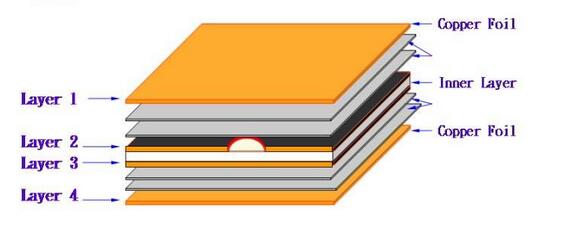Process technical tips for improving laminated quality of multilayer PCB
As a result of the rapid development of electronic technology, the continuous development of printed circuit technology has been promoted. PCB board through one-sided, double-sided to multi-layer development. Multilayer board is in the development direction of precise-dense-thin-large or small two extremes.
And an important process of multilayer PCB manufacturing is lamination, so to ensure the laminated quality of the multilayer board, it is necessary to have a better understanding of the multilayer board lamination process. For this reason, for many years of laminating practice, In this paper, how to improve the lamination quality of the multilayer board is summarized in the following process technology.

Design of inner core board that meets lamination requirements
1. Due to the gradual development of laminated machine technology, the hot press from the previous non-vacuum hot Press to the current vacuum hot press, the hot pressing process in a closed system. Therefore, it is necessary to design the inner laminates reasonably before laminating.
Select the thickness of the core board according to the total thickness requirements of the multilayer PCB, the thickness of the core board is consistent. In particular, more than 6 layers of the multilayer board, each inner layer of the core board warp and weft direction must be consistent
2. There should be certain spacing between the dimensions of the core board and the effects unit. Generally, four layers require spacing greater than 10mm, six layers require spacing greater than 15mm. The higher the number of layers, the greater the spacing
3. Design of positioning hole. In order to reduce the deviation between the layer and the layer, it is necessary to pay attention to the design of the multi-layer board positioning hole. 4 laminates only need to design positioning holes more than 3. More than 6 layers of multilayer board in addition to design positioning holes outside also need to design layers and layers of positioning rivet holes. For positioning holes, rivet holes, tool holes, are generally the higher the number of layers, the higher the number of holes
4. Inner core board requires no opening, short, broken circuit, no oxidation, clean board surface, no residue film
Meet PCB user requirements, select the appropriate PP, CU foil
Customer requirements for PP are mainly manifested in the media layer thickness, dielectric constant, characteristic impedance, voltage resistance, laminate appearance smoothness, and other aspects of the requirements.
Based on years of production experience, I believe that PP can be configured with 7628, 7630 or 7628+1080, 7628+2116, etc., when laminated with 4 laminates More than 6 layers of multilayer board PP selection is mainly 1080 or 2116, 7628 mainly as the increase of dielectric layer thickness. At the same time, PP requires symmetrical placement.
CU foil is mainly configured according to PCB user requirements.
Inner layer core board treatment process
The treatment process of the inner layer board has black oxidation treatment technology and tan treatment technology.
1. Increase the surface of the inner layer of copper foil in contact with the resin
2. Increase the effective wetting of copper foil when melting resin flows
3. Block the effect to the copper surface due to the decomposition of curing agent at high temperature
4. Improve the acid resistance of multilayer boards
Matching of laminated parameters
The control of laminated parameters of the multilayer board mainly refers to the organic matching of "temperature, pressure and time" of lamination.
According to the experience of multi-year lamination, it is considered that the ideal "temperature, pressure, time" software parameters can be determined only on the basis of the first test pressure is OK.
However, the parameters of "temperature, pressure, and time" can be used to determine the corresponding lamination parameters according to different PP combination structures, different PP suppliers, different PP models, and its own different characteristics.





